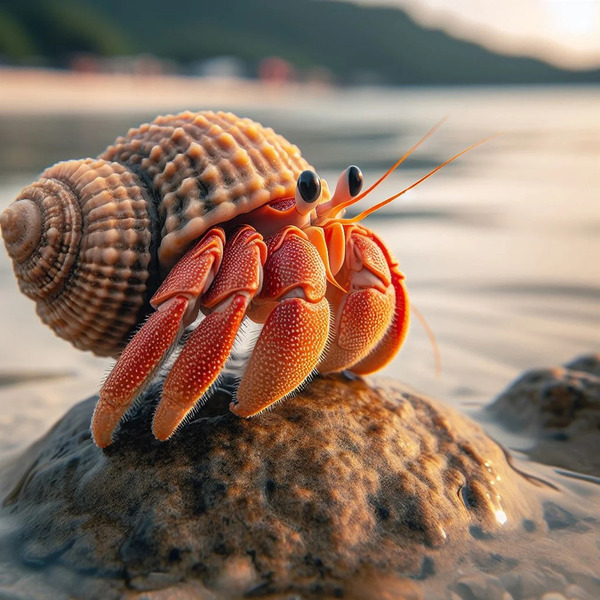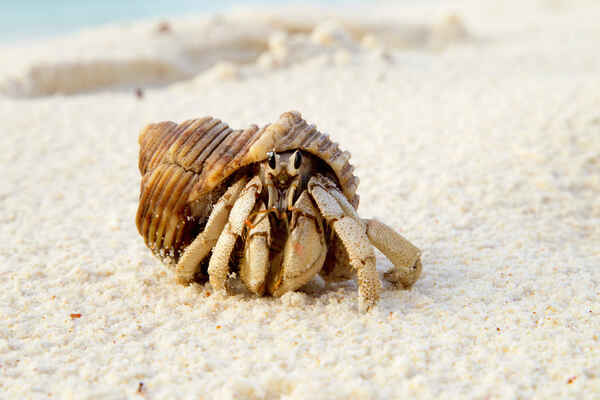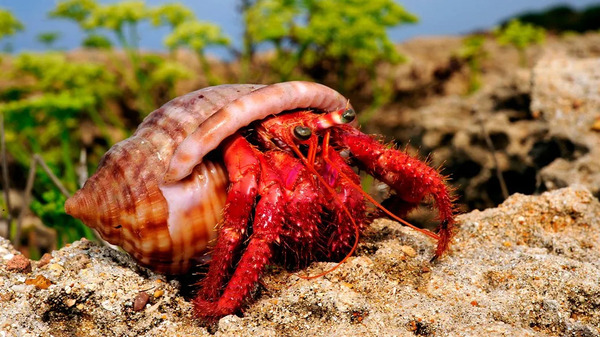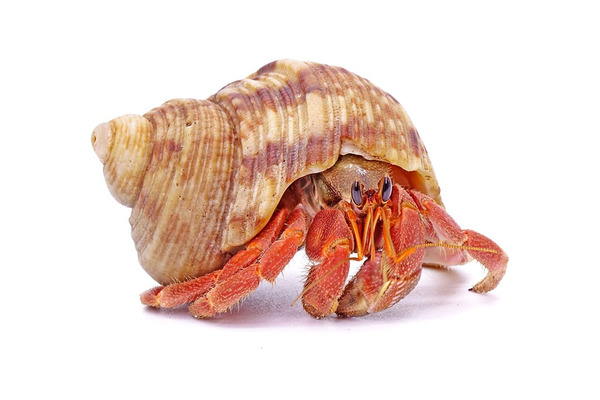Hermit crabs are fascinating pets, known for their quirky behavior and unique ability to change shells as they grow. If you're thinking of adopting one or already have a hermit crab, you may be wondering, “How big will a hermit crab get?” Here, we’ll answer that question and explain what factors influence a hermit crab’s size, growth rate, and overall care.

Hermit crabs are unique and captivating creatures known for their quirky behavior, especially their habit of living in shells discarded by other animals. While they make popular pets due to their low-maintenance needs and interesting behaviors, hermit crabs are complex animals with specific needs. In this article, we’ll explore the world of hermit crabs, including their natural habits, care, and the interesting ways they grow and survive.
Hermit crabs belong to a group of crustaceans that differ from most crabs due to their need to inhabit empty shells. These crabs don’t have their own hard shell covering their abdomen, so they rely on shells from other aquarium/52-marine-animals.html">marine animals, like snails, for protection. Over time, as they grow, they must find larger shells to accommodate their size.
Hermit crabs come in two main types:
Marine Hermit Crabs: Found in oceans and saltwater, they spend most of their time underwater.
Land Hermit Crabs: Often found on beaches or near the shore, they require both land and water to thrive and are commonly kept as pets.
Hermit crabs are naturally found in tropical areas along coastlines where they can move between land and shallow waters. In the wild, they are scavengers, feeding on detritus, algae, small fish, and plant matter. Their behavior is quite social—they often live in groups and engage with each other regularly. Interestingly, hermit crabs will form “shell swapping” gatherings, where they exchange shells to ensure each crab has a properly sized home.
Hermit crabs grow by molting, a process in which they shed their exoskeleton to form a new, larger one. Molting allows the crab to grow, but it is a vulnerable time for them, as they are soft and exposed until the new exoskeleton hardens. After molting, they often search for a new, larger shell.
One of the most fascinating aspects of hermit crabs is their shell-swapping behavior. As they outgrow their shells, hermit crabs will line up in size order, from smallest to largest, and exchange shells, with each one moving up to a larger size. This is crucial for their survival since an improperly fitting shell can make a hermit crab vulnerable to predators and environmental conditions.
Hermit crabs can live surprisingly long lives, especially in the wild or with proper care as pets. While many pet hermit crabs live for about 10-20 years, some have been reported to live up to 30 years in captivity under ideal conditions. Marine species in their natural habitats have even been known to reach up to 40 years. Their longevity depends largely on their species, environment, and the quality of care they receive.
If you’re considering keeping hermit crabs as pets, here are some important factors to ensure they thrive:
Habitat: Hermit crabs need a humid, warm environment to mimic their natural habitat. This means maintaining a temperature range of 75-85°F (24-29°C) and humidity around 70-80%. Provide both fresh and saltwater pools to accommodate their need for both types of water.
Tank Setup: Hermit crabs need a variety of hiding places, sand for digging and molting, and climbing structures for exercise. A 10-gallon tank is usually suitable for one or two small hermit crabs, but larger groups or bigger species will require more space.
Diet: Hermit crabs are omnivores, meaning they eat both plants and meat. A balanced diet should include fresh fruits, vegetables, protein sources like shrimp or fish, and a calcium source to strengthen their exoskeleton. Crushed eggshells or cuttlebone are good sources of calcium.
Shell Options: Offer a selection of empty shells of various sizes and shapes, as hermit crabs need to switch shells as they grow. Shells with smooth, rounded openings are generally more comfortable for most species.
Handling: While hermit crabs can be handled gently, they should not be held frequently. They are delicate creatures and can become stressed easily, so avoid excessive handling to prevent stress.
Social Creatures: Hermit crabs are highly social animals and can become stressed if kept alone. Many owners keep them in pairs or small groups so they can interact with each other.
Variety of Species: There are over 800 species of hermit crabs, with only a few commonly kept as pets. They vary widely in size, color, and habitat needs.
No Permanent Shell: Unlike other crabs, hermit crabs must continue to find and occupy shells throughout their lives to protect their soft bodies.
Long Lifespans: With proper care, hermit crabs can live for decades, making them a long-term commitment as pets.
Shell Wars: In the wild, hermit crabs sometimes fight over shells. The crabs will attempt to push and pull at each other’s shells to take the one they want, demonstrating a competitive side for survival.
Hermit crabs are unique, fascinating animals that make interesting pets. While they might seem low-maintenance at first, they have specific environmental and dietary needs to stay healthy and thrive. With proper care, hermit crabs can live long, happy lives, providing endless entertainment with their shell-swapping antics and quirky behaviors. Whether you’re looking to bring a few hermit crabs into your home or simply learning more about these intriguing creatures, hermit crabs offer a fascinating glimpse into the diversity and adaptability of marine life.

The size of a hermit crab depends on its species, environment, and care. Generally, hermit crabs can reach a range of sizes, from a couple of inches to more than a foot in length! Here’s a breakdown of their potential sizes:
Small Hermit Crabs: Many pet hermit crabs, like the Caribbean or Ecuadorian species, grow up to 2-4 inches in shell length. These are commonly found in pet stores and are typically the smaller hermit crab species.
Medium Hermit Crabs: Some species, such as the Purple Pincher hermit crab, can grow larger and reach around 5-6 inches long, including the shell.
Large Hermit Crabs: The Giant Hermit Crab, or Coconut Crab, is the largest species and can grow up to 12 inches or more in length! However, these large crabs are usually found in the wild and rarely kept as pets due to their size and specific care requirements.
Most pet hermit crabs will fall into the small to medium size range, depending on the species and how well they’re taken care of.
Hermit crabs grow by molting, which means they shed their old exoskeleton to allow room for a larger one. Several factors can affect how quickly and how large a hermit crab grows, including:
Species: The most important factor in a hermit crab's growth potential is its species. Smaller species, like the Ecuadorian hermit crab, will always be smaller than larger ones, such as the Purple Pincher or Coconut Crab.
Environment: A hermit crab’s habitat can impact its size. Proper temperature, humidity, and substrate all support healthy growth. Hermit crabs thrive in warm, humid environments similar to tropical coastal climates. A lack of these conditions can slow their growth.
Diet: Nutrition is crucial for a hermit crab’s growth. Feeding your crab a balanced diet with a variety of fresh fruits, vegetables, calcium sources, and protein-rich foods (like fish or shrimp) will support proper molting and growth.
Shell Availability: Hermit crabs need access to progressively larger shells as they grow. Without an adequate selection of shells, a hermit crab may struggle to molt and could become stunted in growth.
Hermit crabs are relatively slow growers. On average, a pet hermit crab can take several years to reach full size. Smaller species might only take a few years to reach their maximum size, while larger species could take decades. Purple Pincher hermit crabs, for example, can live 10-20 years in captivity, and their growth will be spread over their long lifespan.
Hermit crabs have surprisingly long lifespans. In captivity, they can live for 10 to 20 years or more if properly cared for. Some larger hermit crabs, such as those kept in pristine natural habitats, have been known to live up to 30 years. Lifespan and growth are closely related because a hermit crab that’s well-cared-for and able to live longer will continue to molt and grow throughout its life.
To help your hermit crab grow to its full potential size, focus on these care essentials:
Create a Natural Environment: Ensure your crab’s habitat mimics its natural coastal environment. Keep the tank warm (75-85°F) and humid (70-80%) and provide a mixture of sand and coconut fiber for substrate, allowing for easy burrowing and molting.
Provide a Nutritious Diet: Feed a balanced diet with fruits, vegetables, protein sources, and calcium to aid in molting and exoskeleton health.
Offer an Abundance of Shells: Hermit crabs need access to a variety of shells in different sizes. Ensure the openings of the shells vary slightly to allow for preference and proper fit as they grow.
Handle with Care: Hermit crabs are delicate, especially during molting. Limit handling, as it can be stressful for them. Let them grow at their own pace in a secure, enriched environment.
The title of the largest hermit crab goes to the Coconut Crab, sometimes called the “Giant Hermit Crab,” which can grow up to 3 feet from claw to claw and weigh over 9 pounds. These crabs are terrestrial, primarily living on islands in the Indian and Pacific Oceans. While they are technically a type of hermit crab, Coconut Crabs do not use shells as adults, instead relying on their hardened exoskeletons for protection.
Hermit crabs are unique pets that can grow to surprising sizes, depending on the species, care, and environment. While most pet hermit crabs will stay relatively small, with some growing to medium sizes, others in the wild—like the Coconut Crab—can reach impressive dimensions. By providing the right habitat, diet, and shells, you can ensure your hermit crab grows healthily and comfortably.
Hermit crabs are fascinating pets, known for their quirky behavior and unique ability to change shells as they grow. If you're thinking of adopting one or already have a hermit crab, you may be wondering, “How big will a hermit crab get?” Here, we’ll answer that question and explain what factors influence a hermit crab’s size, growth rate, and overall care.
The size of a hermit crab depends on its species, environment, and care. Generally, hermit crabs can reach a range of sizes, from a couple of inches to more than a foot in length! Here’s a breakdown of their potential sizes:
Small Hermit Crabs: Many pet hermit crabs, like the Caribbean or Ecuadorian species, grow up to 2-4 inches in shell length. These are commonly found in pet stores and are typically the smaller hermit crab species.
Medium Hermit Crabs: Some species, such as the Purple Pincher hermit crab, can grow larger and reach around 5-6 inches long, including the shell.
Large Hermit Crabs: The Giant Hermit Crab, or Coconut Crab, is the largest species and can grow up to 12 inches or more in length! However, these large crabs are usually found in the wild and rarely kept as pets due to their size and specific care requirements.
Most pet hermit crabs will fall into the small to medium size range, depending on the species and how well they’re taken care of.

Hermit crabs grow by molting, which means they shed their old exoskeleton to allow room for a larger one. Several factors can affect how quickly and how large a hermit crab grows, including:
Species: The most important factor in a hermit crab's growth potential is its species. Smaller species, like the Ecuadorian hermit crab, will always be smaller than larger ones, such as the Purple Pincher or Coconut Crab.
Environment: A hermit crab’s habitat can impact its size. Proper temperature, humidity, and substrate all support healthy growth. Hermit crabs thrive in warm, humid environments similar to tropical coastal climates. A lack of these conditions can slow their growth.
Diet: Nutrition is crucial for a hermit crab’s growth. Feeding your crab a balanced diet with a variety of fresh fruits, vegetables, calcium sources, and protein-rich foods (like fish or shrimp) will support proper molting and growth.
Shell Availability: Hermit crabs need access to progressively larger shells as they grow. Without an adequate selection of shells, a hermit crab may struggle to molt and could become stunted in growth.
Hermit crabs are relatively slow growers. On average, a pet hermit crab can take several years to reach full size. Smaller species might only take a few years to reach their maximum size, while larger species could take decades. Purple Pincher hermit crabs, for example, can live 10-20 years in captivity, and their growth will be spread over their long lifespan.
Hermit crabs have surprisingly long lifespans. In captivity, they can live for 10 to 20 years or more if properly cared for. Some larger hermit crabs, such as those kept in pristine natural habitats, have been known to live up to 30 years. Lifespan and growth are closely related because a hermit crab that’s well-cared-for and able to live longer will continue to molt and grow throughout its life.
To help your hermit crab grow to its full potential size, focus on these care essentials:
Create a Natural Environment: Ensure your crab’s habitat mimics its natural coastal environment. Keep the tank warm (75-85°F) and humid (70-80%) and provide a mixture of sand and coconut fiber for substrate, allowing for easy burrowing and molting.
Provide a Nutritious Diet: Feed a balanced diet with fruits, vegetables, protein sources, and calcium to aid in molting and exoskeleton health.
Offer an Abundance of Shells: Hermit crabs need access to a variety of shells in different sizes. Ensure the openings of the shells vary slightly to allow for preference and proper fit as they grow.
Handle with Care: Hermit crabs are delicate, especially during molting. Limit handling, as it can be stressful for them. Let them grow at their own pace in a secure, enriched environment.
The title of the largest hermit crab goes to the Coconut Crab, sometimes called the “Giant Hermit Crab,” which can grow up to 3 feet from claw to claw and weigh over 9 pounds. These crabs are terrestrial, primarily living on islands in the Indian and Pacific Oceans. While they are technically a type of hermit crab, Coconut Crabs do not use shells as adults, instead relying on their hardened exoskeletons for protection.
Hermit crabs are unique pets that can grow to surprising sizes, depending on the species, care, and environment. While most pet hermit crabs will stay relatively small, with some growing to medium sizes,

Here's a table detailing some of the most popular species of hermit crabs that are commonly kept as pets, along with specific information about each one:
| Species | Common Name | Size | Habitat Needs | Temperament | Ideal Tank Setup | Notes |
|---|---|---|---|---|---|---|
| Coenobita clypeatus | Caribbean Hermit Crab | Medium (up to 4-6 inches) | Tropical, needs both land and saltwater | Social, calm | 10-20 gallon tank; humidity 70-80%, temperature 75-85°F | Often the most common pet species, known for their sociable nature and easy adaptability. |
| Coenobita compressus | Ecuadorian Hermit Crab | Small to medium (up to 2-4 inches) | Requires higher humidity (80-90%) and saltwater | Active, curious | 10-20 gallon tank; requires fresh and saltwater pools | Known for their faster movement and preference for smaller, lightweight shells. |
| Coenobita rugosus | Ruggie Hermit Crab | Small (up to 1-2 inches) | Tropical, prefers higher humidity | Docile, friendly | Small to medium tank; requires both fresh and saltwater sources | Small size makes them ideal for beginners, but still needs proper care and humidity. |
| Coenobita brevimanus | Indonesian Hermit Crab | Large (up to 8-10 inches) | Requires high humidity and warm temperatures | Strong, independent | Larger tank (20+ gallons); high humidity levels and fresh/saltwater access | Larger, more independent crab with powerful claws; often prefers solitude and ample space. |
| Coenobita perlatus | Strawberry Hermit Crab | Medium to large (up to 4-6 inches) | Tropical, needs saltwater | Social, delicate | 20+ gallon tank; precise temperature and humidity levels | Beautiful red color but needs very specific care; sensitive to changes in environment. |
| Pagurus bernhardus | European Hermit Crab | Small (up to 1-2 inches) | Cooler, temperate waters | Calm, adaptable | Smaller tank with a mix of land and fresh water access | Commonly found in Europe, requires cooler temperatures; less common as a pet outside of Europe. |
Caribbean Hermit Crab (Coenobita clypeatus): This species is commonly recommended for beginners due to its adaptability and ease of care.
Ecuadorian Hermit Crab (Coenobita compressus): Known for its active and curious nature, this species is also suitable for those new to hermit crabs, as long as proper humidity is maintained.
Ruggie Hermit Crab (Coenobita rugosus): Small and easy to care for, this species is ideal for beginners looking for a low-maintenance pet.
Humidity and Temperature: Hermit crabs are sensitive to humidity and temperature levels. Maintain a warm, humid environment that reflects their natural tropical habitat.
Shells: Always provide extra shells of various sizes and shapes for your crabs to switch as they grow.
Diet: Offer a balanced diet including fresh fruits, vegetables, proteins, and calcium to ensure healthy exoskeleton development.
Social Needs: Many hermit crab species are social and do well in groups, but make sure your tank size can accommodate multiple crabs.
With proper care and the right setup, hermit crabs can live for many years, making them a fascinating and rewarding pet choice.
others in the wild—like the Coconut Crab—can reach impressive dimensions. By providing the right habitat, diet, and shells, you can ensure your hermit crab grows healthily and comfortably.
animal tags: hermit-crab
We created this article in conjunction with AI technology, then made sure it was fact-checked and edited by a Animals Top editor.